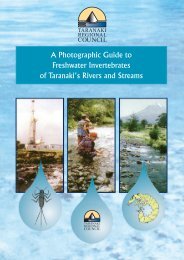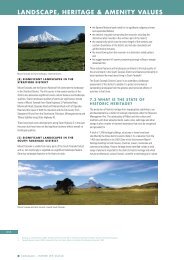Annual report 2006-2007 - Taranaki Regional Council
Annual report 2006-2007 - Taranaki Regional Council
Annual report 2006-2007 - Taranaki Regional Council
You also want an ePaper? Increase the reach of your titles
YUMPU automatically turns print PDFs into web optimized ePapers that Google loves.
MCI value<br />
Number of taxa and MCI values in the Kahouri Stream 20 u/s Piakau<br />
Stream confluence (KHI000480)<br />
140<br />
120<br />
100<br />
80<br />
60<br />
40<br />
20<br />
0<br />
Jan-88<br />
Jan-89<br />
Jan-90<br />
Jan-91<br />
Jan-92<br />
Jan-93<br />
Jan-94<br />
Jan-95<br />
Jan-96<br />
Jan-97<br />
Jan-98<br />
Jan-99<br />
Jan-00<br />
Jan-01<br />
Jan-02<br />
Jan-03<br />
Jan-04<br />
Jan-05<br />
Jan-06<br />
Jan-07<br />
MCI value M edian M CI to date<br />
No. of taxa M edian no. of taxa to date<br />
Figure 10 Number of taxa and MCI values in the Kahouri Stream at site N (KHI000480)<br />
Very few significant differences in individual taxon abundances were found between<br />
adjacent sites G and N. However, subtle decreases in abundances of certain ‘sensitive’<br />
mayfly and cranefly taxa and increases in ‘tolerant’ midges resulted in a decrease in SQMCIS<br />
score of 0.6 units between sites. The MCI score was similar to the score recorded at site G<br />
upstream. The MCI and SQMCIS scores were also similar to their respective medians (Table<br />
2).<br />
Summary and Conclusions<br />
The <strong>Council</strong>’s standard ‘kick-sampling’ technique was used at seven sites to collect<br />
streambed macroinvertebrates from the Kahouri Stream and an unnamed tributary on 17<br />
April <strong>2007</strong>. Samples were sorted and identified to provide the number of taxa (richness),<br />
MCI and SQMCIS scores for each site.<br />
The MCI is a measure of the overall sensitivity of the macroinvertebrate community to the<br />
effects of organic pollution in stony streams. It is based on the presence/absence of taxa with<br />
varying degrees of sensitivity to environmental conditions. It may be used in soft-bottomed<br />
streams to detect trends over time. The SQMCIS takes into account taxa abundance as well as<br />
sensitivity to pollution, and may reveal more subtle changes in communities, particularly if<br />
non-organic impacts are occurring.<br />
Significant differences in either MCI or SQMCIS between sites indicate the degree of adverse<br />
effects (if any) of discharges being monitored.<br />
This summer survey of macroinvertebrate communities in the Kahouri Stream indicated that<br />
the communities directly downstream of the tributary that receives the <strong>Taranaki</strong> Abattoirs<br />
and Ballance Agri-Nutrients discharges were significantly different than those upstream,<br />
where taxa richness and MCI score were slightly healthier than median community<br />
conditions recorded previously at this ‘control’ site. There was a significant decrease in MCI<br />
and SQMCIS scores at the lower site, which may have been due to additional instream<br />
nutrients supplied by the tributary. This is likely to be due to the impacts from the abattoir,<br />
but this is unclear without further monitoring. Therefore it is recommended that additional<br />
sites be included in subsequent surveys to assess the impact of the abattoir discharge on this<br />
unnamed tributary.<br />
13<br />
70<br />
60<br />
50<br />
40<br />
30<br />
20<br />
10<br />
0<br />
No. of taxa














